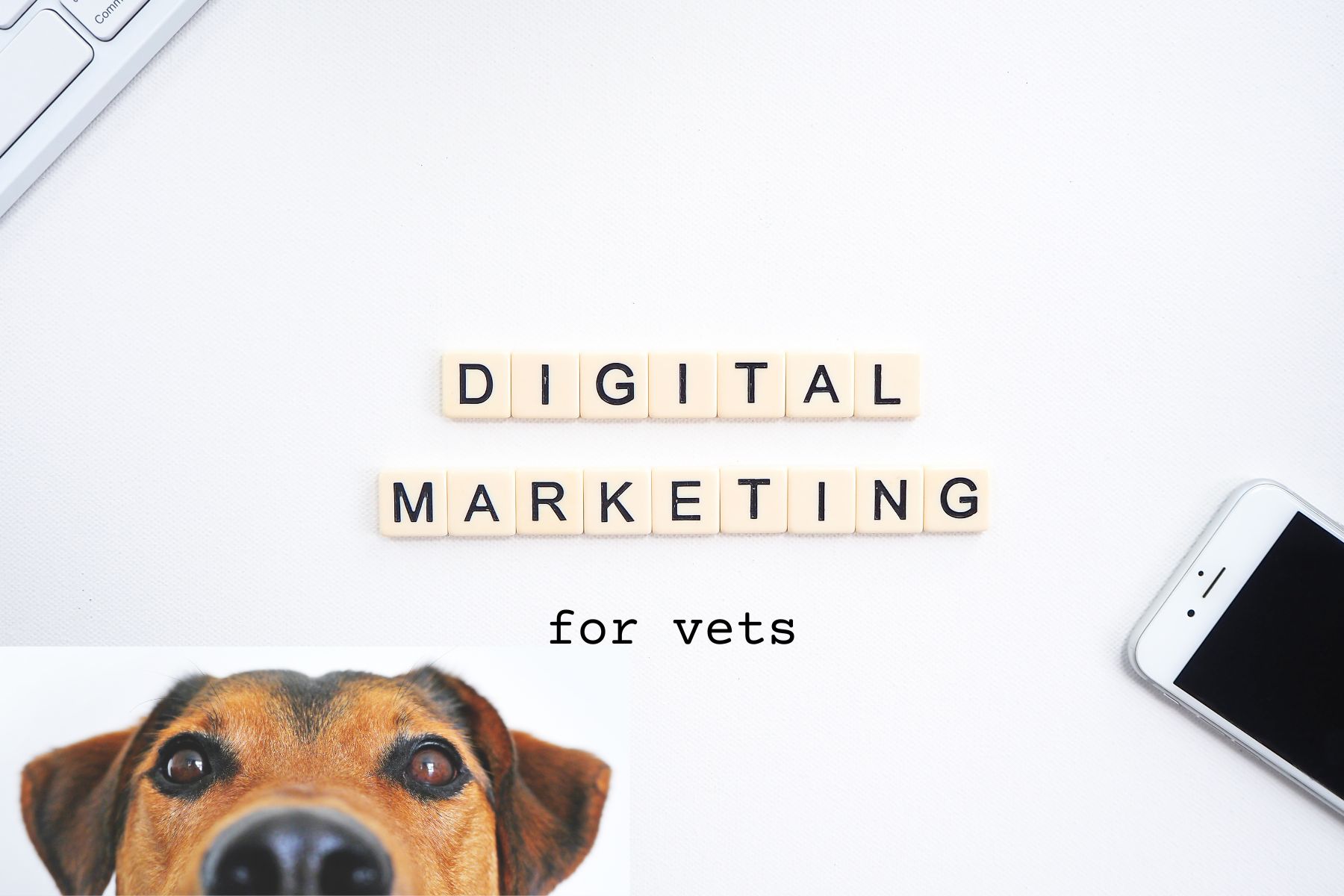Digital marketing for vets can feel like a bit daunting topic. After all, it’s not something that was covered in vet school (though times may be changing…)! What does it actually mean? How can you use it to promote your business? While some of the technical jargon can be a bit off-putting you are probably already familiar with some of the different types of digital marketing available. Let’s look at it in more detail as well as how can use the various kinds to boost your vet practice’s profile.
What is digital marketing?
Digital marketing (also known as online marketing) is a way of advertising that uses the internet. There are several different ways that this can be done, with many businesses using multiple techniques to reach out to potential and existing customers. Digital marketing is rapidly taking over from some more traditional methods of advertising such as leaflet drops and printed adverts.
Do vets need digital marketing?
In short, yes! The most cost-effective way of reaching a wide audience is through digital marketing. Plus, most clients expect to get news or receive offers online these days, just as they would from most other businesses. Digital marketing also allows vet practices to sell themselves like never before. Owners want to get an insight into your practice and will look online for what makes you stand out from your competitors.
6 types of digital marketing for vets
1. Practice website
First impressions count, and your practice website needs to make a good one. This is where most potential clients will come to find out more about your veterinary business. It is therefore important that your website is professional and kept regularly updated. You should use it as a platform to advertise all of the services that you offer, including anything that makes you stand out from your competitors (e.g. longer opening hours, vets with additional qualifications, the ability to treat exotic species and so on).
2. Practice blog
A veterinary practice blog is a great way of engaging with new and existing clients. By posting regularly on current veterinary topics and answering common client questions, you can showcase your team’s expertise as well as helping to educate pet owners. If your staff are strapped for time, then you can employ the services of a veterinary content-creating service that can help write bespoke pieces on your behalf.
3. Local search engine optimisation
Local search engine optimisation (SEO) is a technical term which describes how likely your business is to appear at the top of a search engine’s page (e.g., Google). SEO for vets is important as a new client searching for a vet practice in their area will find you more easily if you appear near the top of the list. Ways you can improve your SEO during local searches include using certain keywords on your website, such as the name of your town or region. You should also actively monitor and respond to reviews left about your business, as well as ensure that information on business directories (like Yelp) is accurate.
4. Social media
Social media is vital for businesses these days. It allows you to directly interact with your customers, but it is also a way of reaching potential new ones too. Clients love seeing pictures of their pets (with consent of course!), interesting clinical cases and getting news about the practice team. Lots of likes and shares mean that your practice becomes visible to others, which in turn can generate more vet practice website traffic. Again, for the time-poor practice, services exist to help you put out regular content on social media pages to keep things ticking along.
5. Targeted advertisement
Location-based advertisements on websites such as Google are a way of targeting an audience within a certain radius of your practice. It is possible to pay for an advert so that a link to your practice website appears higher on the Google search results list than an ‘organic’ competitor (it will feature the word ‘ad’ next to it though). This may mean more people click on your website first. Social media adverts can even target people of a certain age or with particular interests (e.g. animals or cats) so that your adverts appear in their news feed as they are scrolling. This helps to make sure the money that you are spending on advertising is reaching the right people and stops you from wasting your marketing budget on people that are unlikely to need your services.
6. Email campaigns
Vet email campaigns are a way of continually engaging with your existing clients and driving footfall into your practice. You can run campaigns to target specific customers, such as offering a discount on vaccinations for those that have lapsed or offering dentals at a reduced cost for pets over a certain age. Alternatively, you can email everyone with practice news or information about things like your health care plans. Most practice management systems can help perform these tasks and it usually works out cheaper than postal services. This is why your team must record the email addresses of all newly registered clients, but also ask for their consent for marketing emails. These emails are a great way of encouraging clients to keep coming back in to see you.
FAQs about digital marketing for vets
How can I promote my veterinary business?
There are many ways to promote your veterinary business. These include various digital marketing techniques such as a professional website, a vet practice blog, social media, email campaigns and targeted advertisements. Some practices rely almost solely on these whereas others will also use more traditional methods like printed advertisements.
How do I get new veterinary clients?
Leaflet drops, posters and printed advertisements tend to be expensive and don’t often bring in as many numbers as you might think. Instead, new clients are often generated through social media, through good existing client feedback/online reviews and via targeted advertisements. Appearing at the top of a search engine list also helps – for that you’ll need good Search Engine Optimisation (SEO).
What social media do vets use?
Most practices focus on using Facebook to promote their business as it allows for a wide variety of information to be posted, including photos, videos and text. Some practices also use Instagram which focuses on pictures, YouTube to post longer educational videos, and Twitter for snappy updates.
Conclusion
Hopefully, you now have more of an understanding of the different types of digital marketing for vets. Marketing for veterinarians relies very strongly on the techniques we have described, so it is important that you have a plan in place for how you want to present your practice. But as well as focussing on the serious marketing strategy side of things, remember to have fun with it too! Engaging with new and existing clients via social media and veterinary blogs can be very rewarding, so embrace the technology!
-
Content Planning for your Vet Practice
Your digital content is an important part of the marketing strategy for your business but is also an online representation of your practice. If your content proves popular, it could… Read more
-
Running Great Vet Email Campaigns (Our Top Tips)
If you’re a vet practice manager, owner, or marketer, you might already be contacting clients by email, either with practice news, appointment reminders, or clinical information. But have you considered… Read more
-
Marketing for Veterinarians: Making a Marketing Plan
For some vets, marketing can feel like a challenge. With so many bits of jargon and different costs involved, it can be hard to know where to begin! The good… Read more
-
What makes ‘good’ vet blog content?
Many vet practices have an online blog now, it’s a great way of engaging with customers remotely. But how can you make sure yours stands out? With so many benefits of… Read more
-
3 veterinary blog post ideas for every month of the year
There are so many benefits of a vet practice blog but it can be hard to come up with inspiration for regular fresh content! If you’re not sure what your practice should… Read more


